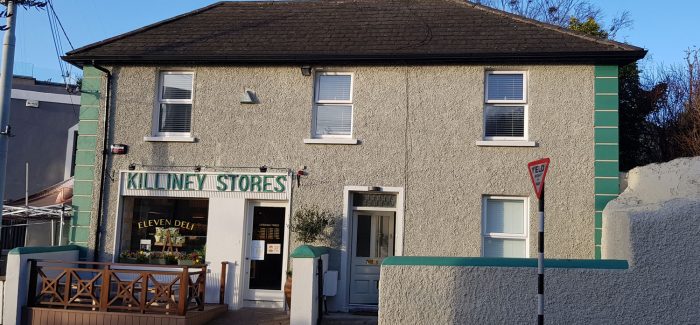Bayview-Killiney Stores
| Name | Bayview-Killiney Stores |
|---|---|
| Previous Names | Killiney Telephone Exchange |
| Address | Killiney Hill Road |
| Year Built | 1876* |
| Exists today | Yes |
| On 1888 map | Yes |
Map of 1888
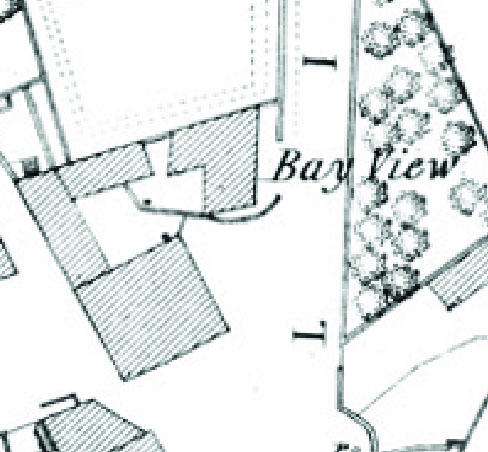
Possible reference to an earlier building which existed at this location in 1876
John Donegan is listed as proprietor of The Killiney Hotel in various directories from 1867-1884. It would appear that ‘The Killiney Hotel’ is the building which we now know as The Druid’s Chair pub. Given it’s proximity to the road and it’s long standing connection to the Druid’s Chair pub it is likely that the newspaper article below is referring to the building of Bayview in 1876. The house is clearly indicated on the 1888 map but the earlier 1866 map shows what appears to be a yard in this location. No other buildings in the village are as close to the centre of the road on the 1888 map. Perhaps Donegan got away with the fine and managed to retain the house in this location.
This transcription of the newspaper report would appear to confirm the erection of a house at this site:
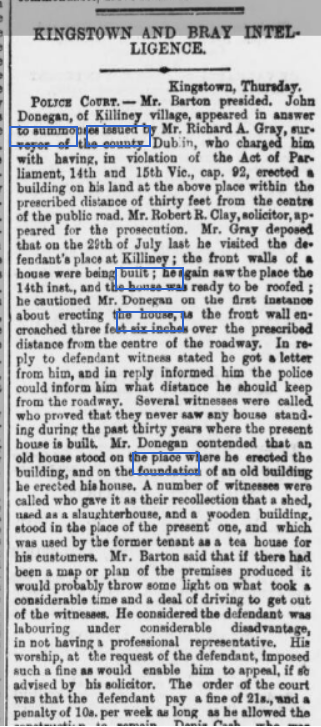
Police Court.- Mr Barton presided. John Donegan of Killiney village appeared in answer to summons issued by Mr Richard A. Gray, surveyor of the county Dublin, who charged him with having in violation of the Act of Parliament, 14th and 15th Vic., cap. 92, erected a building on his land at the above place within the prescribed distance of 30 feet from the center of the public road. Mr Robert R. Clay solicitor appeared for the prosecution. Mr. Gray deposed that on the 29th of July last he visited the defendant’s place at Killiney; the front walls of a house were being built; he again saw the place the 14th inst., and the house was ready to be roofed; he cautioned Mr Donegan on the first instance about erecting the house as the front wall encroached 3 feet 6 inches over the prescribed distance from the center of the roadway. In reply to defendant witness stated he got a letter from him and in reply informed him the police could inform him what distance he should keep from the roadway. Several witnesses were called who proved that they never saw any house standing during the past 30 years where the present house is built. Mr Donegan contended that an old house stood on the place where he erected the building and on the foundation of an old building he erected his house. A number of witnesses were called who gave it as their recollection that a shed used as a slaughterhouse and a wooden building stood in the place of the present one and which was used by the former tenant as a teahouse for his customers. Mr Barton said that if there had been a map or plan of the premises produced it would probably throw some light on what took a considerable time and a deal of driving to get out of the witnesses. He considered the defendant was labouring under considerable disadvantage in not having a professional representative. His worship at the request of the defendant imposed such a fine as would enable him to appeal, if so advised by his solicitor. The order of the court was that the defendant pay a fine of 21 shillings and a penalty of 10 shillings per week as long as he allowed the construction to remain.
Sale to Peter McKeever in 1882
Peter McKeever’s connection with Killiney can be traced back to 1878 when he was involved with the running of the local post office. The McKeever/Maxwell family went on to become the main players in the commercial life of the village for many years. By 1915 their concerns had extended to include The Victoria Arms Hotel (now the Killiney Plaza apartment development), The Killiney Bar (Druid’s Chair), Bayview, Hillview (now St. Abbey’s), Plasnewyd (now demolished site of Rock Lodge estate), 5 cottages on Talbot Road and a number of other properties in the village. They also owned a pub at 110 and 111 Townsend Street which formed part of the sale of property in 1915.

National Telephone Co. Telephone Exchange
Around 1900 the National Telephone Company entered into a lease on the property and installed a telephone exchange to service the local area. The proprietor of this call office was Edward Fitzhugh and he lived on the premises with his family. An advert for the sale of the property in January 1915 (per instructions of Mrs. Maxwell who is retiring from business) states that Bayview is let to the Postmaster-General as a Telephone Exchange. Around this time Edward’s daughter, Miss M.A. Fitzhugh, took over the running of the call office and she is listed as the proprietor up until 1921.
Killiney Telephone Directory list 1900-1901
In 1900 there was a very select few who could afford the luxury of a personal telephone. At least there were a few others in the area who they could call for a chat.
| Number (prefix was KI) | Name | Address |
| 20 | Bingham, C.H. | The Cottage, Ballybrack |
| 1 | Clay, Robt. Keating | Anglesea, Killiney Road |
| 10 | Geoghegan, Samuel | The Grove, Killiney |
| 11 | Guinness, RD | Shanganagh Grove, Ballybrack |
| 6 | Jacob, Wm. B. | Ballybrack House |
| 18 | Loughlinstown Union | Loughlinstown |
| 8 | MacDonald, W.A. | 13 Shanganagh Terrace |
| 13 | Mecredy, T.T. Jun. | Ardkill, Strathmore Road |
| 16 | Mooney, D. | Carrickmoleen |
| 0199 | Mooney, Gerald J.P. | Vartry to Killiney |
| 12 | Murphy, Frank D. | Ardravinn, Killiney |
| 5 | Shannon, Wm. J. | Killeen, Killiney |
| 17 | Waldron, L.A. | Marino, Killiney |
| 0200 | White, E. Solr. | Ashton, Killiney Park |
Unexplained fire and tragedy at Killiney Telephone Exchange, March 1921.
During the War of Independence the property became a target for attacks and a number of incidents were reported in the press from this era. A newspaper report on the fire mentioned that it was interesting to note that within the past 48 hours a number of telephone exchanges in this particular district had been raided. Ultimately the building was burned down in March 1921 and appears to have remained in an uninhabitable state for a number of years afterwards. The attack on the building turned out to be fatal and resulted in the death of Edward Fitzhugh’s son, Desmond aged 11. The rest of the family were lucky to escape with their lives. The building was completely destroyed.

The tragic story is transcribed here.
Family’s Hairbreadth Escape. Tragedy attended a fire which last night completely destroyed the telephone exchange on Killiney Hill, Co. Dublin, the victim being Desmond Fitzhugh, aged 11, youngest son of the resident operator. Mrs. Fitzhugh and the rest of her family, consisting of three sons and three daughters had hairbreadth escapes being compelled to jump from the upper windows of the burning building in their night attire. The cause of the conflagration has not been ascertained. Nothing remains of the building save the blackened walls.
The telephone exchange was a two story building near the top of Killiney Hill just outside the Victoria Park and close to Kennealy’s Hotel and grocery establishment. The outbreak occurred about midnight and the flames spread with terrible rapidity. Mrs. Fitzhugh and those of her children who escaped had barely time to open the bedroom windows and drop to the ground in their night attire before the whole building became a seething furnace. It was not until later on when all chance of rescue was out of the question that poor Desmond was missed by his mother, sisters and brothers.
Mother’s agony. The agony of the mother on making this terrible discovery can be better imagined than described. The narrowness of her escape is testified by the fact that her hair was badly burned. Miss Kathleen Fitzhugh, her eldest daughter who attended to the switchboard, sustained burns to her hands whilst Mr. George Fitzhugh was burned on the upper lip. The hair of both was also singed. The tragedy has caused a great sensation in the district and the deepest sympathy is felt for Mrs. Fitzhugh and the family in their terrible bereavement. The boy who lost his life was a student at the Christian Brothers School, Dun Laoghaire. The eight room building was completely destroyed, only blackened walls and smoking ruins being visible when day broke.
Mystery of the Outbreak. The affair is regarded as a most mysterious one and the cause of the outbreak has not been ascertained. Several members of Mrs. Fitzhugh’s family told our representative that outside the house, a couple of yards from the window of the switch room, they saw an oil can like a painters can. The authorities however failed to find this can, although they searched specially for it. The charred remains of the boy were found early this morning by a member of Dalkey Fire Brigade. Mr Arthur Fitzhugh, a brother of the poor boy, is an assistant in the Dublin Town Clerk’s Office, and another brother, Mr Walter Fitzhugh is an operator in the Central Telephone Exchange, Crown Alley, Dublin. Mr Walter Fitzhugh was on duty in the city until six o’clock this morning and only became aware of his brother’s tragic death when he arrived at Westland Row station on his way home.
Surviving Brothers Story. Mr Arthur Fitzhugh, interviewed by our representative this morning, stated that the house consisted of eight rooms; the switch room, kitchen, parlour and another apartment being on the ground floor, and three bedrooms and a sitting room on the upper floor. His mother and three sisters slept in one bedroom, three brothers George, Myles and Desmond in another room, and Mr Fitzhugh himself in the bedroom over at the switch room. About 11:30 last night one of my sisters had occasion to go downstairs but she did not notice anything wrong and she went back to bed about 12 o’clock. Some time afterwards I was awakened by the fumes and the light of the flames. Immediately I jumped up and ran out on the landing and attempted to get down the stairs but I found that the entire ground floor of the house was on fire and that the flames were coming up the stairs. My room was over the switch room, and when I could not get down the stairs I ran to the window and jumped a height of from 12 feet to 15 feet to the ground. I then ran round to the other side of the house, he continued, and saw my mother in the sitting room on the upper story apparently very weak and crying for help. At this time help was forthcoming from many of the villagers including Mr Kennealy and his brother-in-law, Mr Walter O’Brien. We got hold of an old trap which was convenient and ran it up against the wall of the house and used it as a fire escape. In that way we rescued my mother.
Rescue Efforts. We then proceeded to the right hand side of the house where my sisters were in the room over the parlour, when we found that they had escaped from the burning house by jumping from the windows. Then again we returned to the back of the house and ascertained that two of my brothers had also saved their lives by jumping from the windows of their rooms, but my younger brother was missing. Then I endeavoured to get into his room and succeeded in getting up on the window sill, but, owing to the fumes and flames I had to jump down immediately as the whole house was enveloped in fire. It was impossible to make any further attempt to rescue my youngest brother. Mr Walter O’Brien then yoked a pony and trap and drove into Dalkey where he reported the matter to the D.M.P. The first thing I noticed when I got out of the house was an oil can like a painters can, which was about three or four yards from the switch room.
Slept in Same Room as Victim. Mr. George Fitzhugh, who slept in the same room with Desmond, told our representative that he was awakened by the fumes. I attempted to get out by running towards my mother’s room and saw some figures on the landing. I could not make out who they were but I heard someone shouting that the whole house was on fire. I then ran back to my own room again lifted the window and jumped down into the right after me.
Claims for damages
The newspaper report of 1924, below, indicates that the building was destroyed as a result of a fight between National troops and irregulars. At the time the nearby Glenalua House, now called Mount Prospect, was an outpost for the Freestate army and was under constant attack during the course of the Civil War.
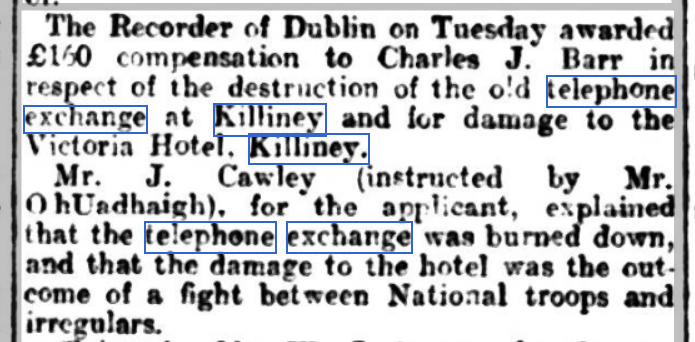
Proposed Auction of 19th October 1921

A further advert for this auction states that the sale was proceeding ‘per instructions of Mr. William Kinneally, in consequence of his purchase of a farm in Co. Wicklow, to which he intends devoting his entire attention’. Mr. Kinneally decided to move on after the attack and put his property, which consisted of ‘The Killiney Bar’, ‘Bayview’ and Nos. 2 and 3 Talbot Road up for auction. The Bay View property ‘consists of the site and walls of the premises’.
Plans to rebuild the house
Plans were prepared in January 1923 by W.M. Mitchell & Sons architects on behalf of Mr. Charles Barre to rebuild and convert the building into a tea-room with bedroom accommodation overhead.

These proposals did not get the go ahead and another proposal, this time for Stephen McGuinness c.1925, did proceed. These plans indicated that the building was to return to full residential use and the photograph below which was provided by Anthony Deegan of Glenalua Road confirms that the plans below were executed as shown.

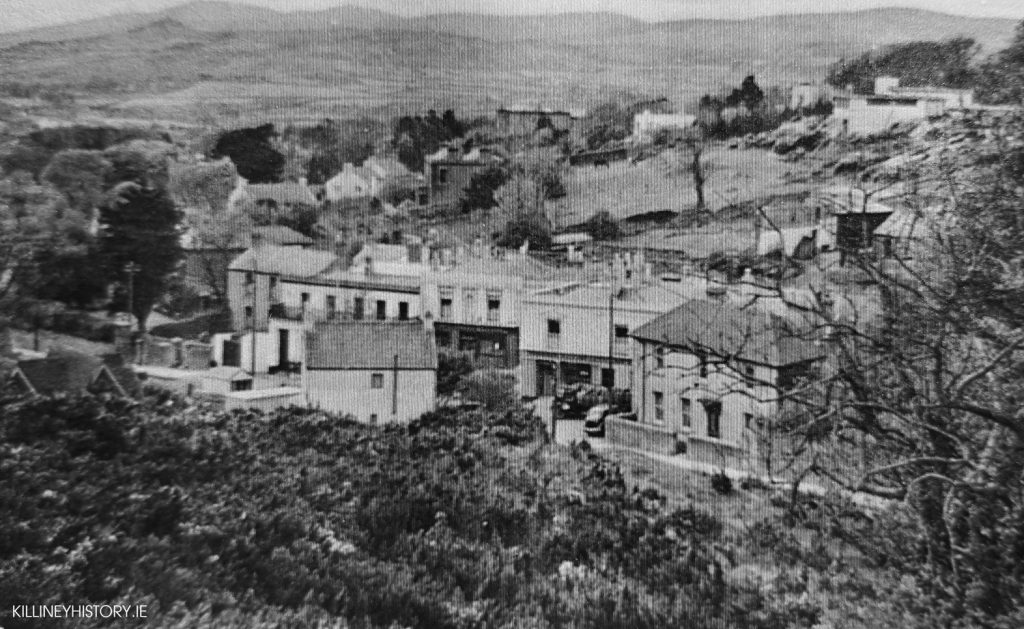
Barre’s ‘Killiney Bar’ and McGuinness’s Hotel
Bayview has had a long association with the building which we now know as The Druid’s Chair public house. From newspaper reports of the time it appears that Charles Barre was the proprietor of ‘The Killiney Bar’ and was most likely the landlord of Bayview and leased the property to the National Telephone Company at the time of the fatal attack. It would also appear that he disposed of his interest in the property sometime around 1925 when Stephen McGuinness appears on the scene. Thom’s Directory lists Stephen McGuinness as the proprietor of McGuinness’s Hotel in 1928 and 1930. A Patrick McGuinness is also mentioned along with Francis Lacy who are involved with the hotel which we believe to be the Druid’s Chair pub today.
The Rushe connection
An auction notice of August 1936 for a Licensed Premises, Hotel and Restaurant describes Lot 1 as ‘Killiney Bar’ and Lot 2 as ‘Bayview’. It appears that Bayview was acquired by John Rushe around this time and the Rushe name is associated with the property up until 1963 when it was acquired by Thomas Clarke.

Clarke’s Killiney Stores
Tom Clarke acquired Bayview as their family residence in June 1963 and opened Killiney Stores in a section of the ground floor which was to be run by his wife. Mr. Clarke had a well known butcher shop in Glasthule. When Mrs. Clarke retired the business was taken over by her son Michael who ran it with his brother Peter until it’s closure in 2018. The closing of Clarke’s Killiney Stores after 55 years marked the end of an era in the history of the village and the entire community turned out to wish Michael and the family well.
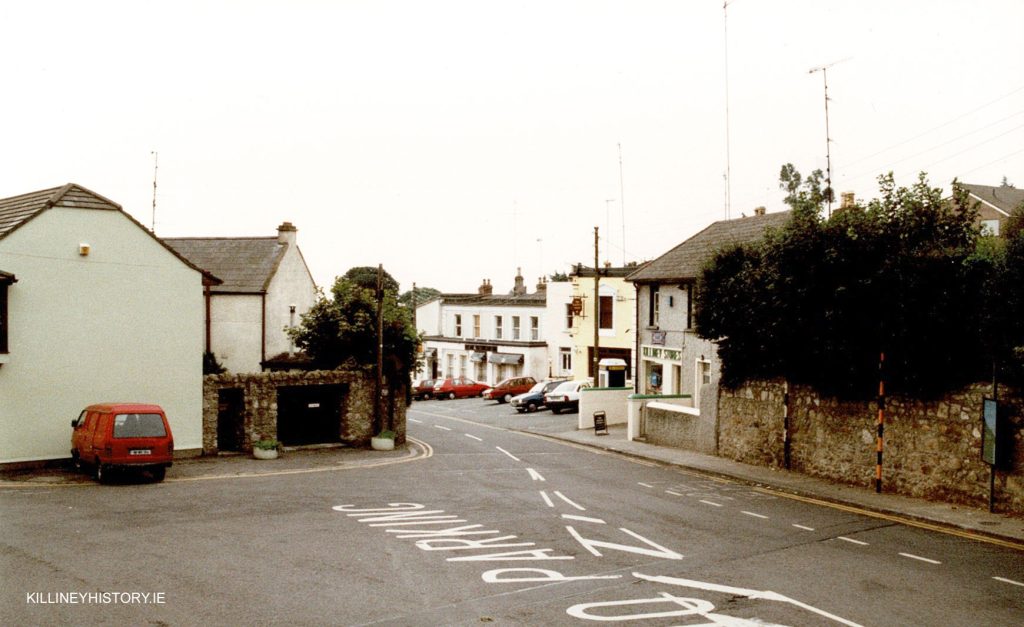
Bayview today
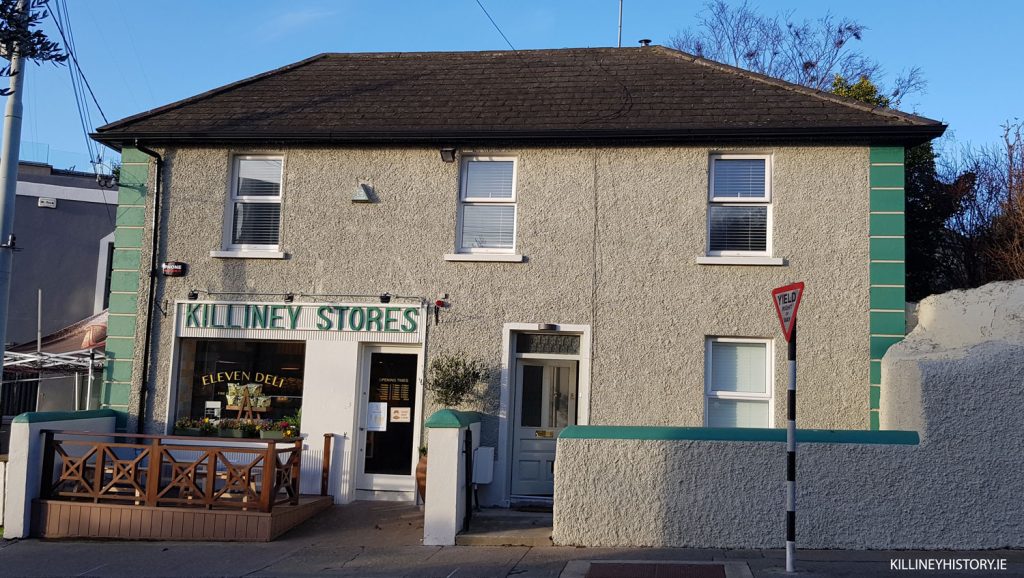
We are fortunate that the new occupants of Killiney Stores have retained the original features including the sign which was handmade by Thomas Clarke when he first opened up shop back in 1963. It looks little changed now to how it appeared over half a century ago and we wish Eleven Deli every success for the future as they continue to serve the community and visitors alike.
Timeline from Thom’s Directory and other sources
| Year | Occupier | Name of premises | Source of information |
| 1876 | John Donegan | House | Newspaper report of illegal building |
| 1880 | Turbit, Mrs | Haberdasher, Bayview ho. | Thom’s |
| 1882 | Mr. P. McKeever | ‘Licensed concerns and adjoining dwelling house’ | Newspaper report. ‘Premises of John Donegan sold in one lot to Mr. P. McKeever for £1,150’. |
| 1898 | Fyfe, Robert, confectioner | Bayview | Thom’s |
| 1900 | Vacant | Bayview | Thom’s |
| 1905-1912 | Fitzhugh, Edward J. | National Telephone Co. | Thom’s |
| 1915 | Mrs. Maxwell | Bayview | Advert. Notice of auction |
| 1917-1921 | Fitzhugh, Miss M.A. | Telephone Call Office | Thom’s |
| 1921 | William Kinneally | Killiney Bar and Bayview | Advert. Notice of auction ‘per instructions of Mr. William Kinneally’ |
| 1922 | Charles Barre | Barr’s Hotel | Newspaper report of robbery |
| 1923 | Mr. Barre | Licensed premises | Newspaper report. Proprietor summoned for breaching the Licensing Act. |
| 1923 | Charles Barre | Old Telephone Exchange | Plans for reconstruction of Bayview. Architectural Archive. |
| c.1925 | Stephen McGuinness | Bayview | Plans for reconstruction of Bayview. Architectural Archive. |
| 1928-30 | Stephen McGuinness | McGuinness’s Hotel | Thom’s. Also mentions Patrick McGuinness and Francis Lacy. |
| 1930 | Douglas, Frank | Bayview | Thom’s |
| 1934 | Buckley, George R. | Bayview | Thom’s |
| 1936 | Killiney Bar and Bayview | Advert. Notice of auction and later report of confirmation of sale to new owner. | |
| 1937-1954 | Rushe, John | Killiney Hotel, Bayview | Thom’s |
| 1960 | Rushe, Michael | Bayview | Thom’s |
| 1963 | Clarke, Thomas | Killiney Stores, Bayview | Michael Clarke |
| 1971 | Clarke, Thomas | Killiney Stores, Bayview | Thom’s |
| 1975 | Clarke, Thomas | Killiney Stores, Bayview | Thom’s |
